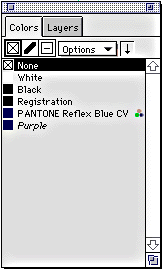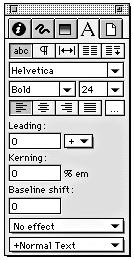Because we are a spot
printer, we must ask that all colors be converted to spot colors.
Whether mixing your own colors using the Color Mixer or importing
process colors from a color-matching library, the color must
be converted from process to spot colors. To do this, select
the color from the Color List and select Make Spot under
the pull-down Options menu. To discern between spot and
process colors, Freehand designates particular type styles.
If the color name is italicized, the color is process. If the
color name is displayed as regular Roman type, the color is
spot. In order to print separations correctly, we ask that all
colors be converted to spot.
To organize your colors more effectively, please simplify your
color list by removing all unused colors. To do this, choose
an unused color and use the Remove command found under
the Options menu on the Color List. Color discrepancies
must be corrected prior to sending the job.
|

In this example, the Purple is in Process Colors. To convert it to spot, please
choose Make Spot from the pull-down Options menu shown.
|
|
Include
all linked graphic files.
If you send a Freehand file that contains an EPS, TIFF, or any other
placed images, we ask that you send the image file along with the
Freehand file. The Freehand file refers to the information in the
graphic file to print the image properly at high resolution. Without
the separate file, the graphic cannot be printed. Please do not embed
images. Once the image is embedded, it becomes uneditable. We would
much rather have the separate file linked.
Please be aware of our preferred percentages when setting up screens
or gradients. Our ideal screen percentages fall anywhere from 20%
to 40%. For more information on screen percentages, please visit the
corresponding section in Printing
Parameters.
When selecting fonts to create your artwork, select the font from
the font list rather than using the Style Selector in the Text Inspector
to add effects. This will allow for better font organization and assure
proper printing.
|

Correct
|

Incorrect
|
|
|
To avoid
font inconsistencies, please Convert Text to Paths. This uses
the information found in the text's printer font to recreate the individual
letters. Once text has been converted to paths, the information found
in the screen and printer fonts becomes unnecessary. This allows the
file to be font-independent and removes the need to include the fonts.
Visit our font section in General Information
for more on printer and screen fonts.
|
|
|
|


